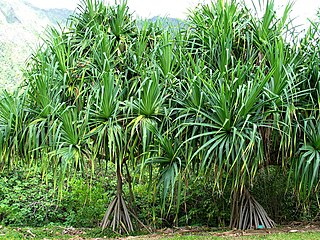
Byfield National Park is a national park in the Shire of Livingstone, Queensland, Australia.

Pandanus is a genus of monocots with some 750 accepted species. They are palm-like, dioecious trees and shrubs native to the Old World tropics and subtropics. The greatest number of species are found in Madagascar and Malesia. Common names include pandan, screw palm, and screw pine. They are classified in the order Pandanales, family Pandanaceae.

Pandanus tectorius is a species of Pandanus (screwpine) that is native to Malesia, eastern Australia, and the Pacific Islands. It grows in the coastal lowlands typically near the edge of the ocean. Common names in English include thatch screwpine, Tahitian screwpine, hala tree, pandanus, and pu hala in Hawaiian. The fruit is sometimes known as hala fruit.

Pandanaceae is a family of flowering plants native to the tropics and subtropics of the Old World, from West Africa through the Pacific. It contains 982 known species in five genera, of which the type genus, Pandanus, is the most important, with species like Pandanus amaryllifolius and karuka being important sources of food. It is an ancient family dating from the early to mid-Cretaceous. This is a family that is not-well studied.

The hymenopteran family Platygastridae is a large group of exclusively parasitoid wasps, mostly very small (1–2 mm), black, and shining, with elbowed antennae that have an eight-segmented flagellum. The wings sometimes lack venation, though they may have slight fringes of setae.

Pandanus amaryllifolius is a tropical plant in the Pandanus (screwpine) genus, which is commonly known as pandan. It has fragrant leaves which are used widely for flavouring in the cuisines of Southeast Asia and South Asia.

Nyctophilus arnhemensis, known as the northern or Arnhem long-eared bat, is a species of Chiroptera (bats) native to northern regions of Australia. The distribution range is from north-western Queensland to northern Western Australia.
The wildlife of Mauritius is composed of its flora and fauna. Mauritius is located in the Indian Ocean to the east of Madagascar. Due to its isolation, it has a relatively low diversity of wildlife; however, a high proportion of these are endemic species occurring nowhere else in the world. Many of these are now threatened with extinction because of human activities including habitat destruction and the introduction of non-native species. Some have already become extinct, most famously the dodo which disappeared in the 17th century.

Pandanus balfourii is a species of plant in the family Pandanaceae, one of four Pandanus species that are endemic to the Seychelles.

Pandanus multispicatus is a species of plant in the family Pandanaceae, one of several Pandanus species that are endemic to the Seychelles.
Pandanus pyramidalis is a species of plant in the family Pandanaceae, endemic to Mauritius.

Pandanus sechellarum is a species of plant in the family Pandanaceae. It is one of five species of Pandanus that are endemic to Seychelles.
Tetracamphilius clandestinus is a species of loach catfish endemic to the Central African Republic where it is found in the Ubangui River. It grows to a length of 2.0 cm.
Megacyclops is a genus of copepods, containing the following species:
Spaniblennius clandestinus is a species of combtooth blenny found in the eastern central Atlantic Ocean. It is known from a single specimen, the holotype, which was collected at Goree in Senegal
Trochulus clandestinus is a species of air-breathing land snail, a pulmonate gastropod mollusk in the family Hygromiidae, the hairy snails and their allies.

The karuka is a species of tree in the family Pandanaceae and an important regional food crop in New Guinea. The nuts are more nutritious than coconuts, and are so popular that villagers in the highlands will move their entire households closer to trees for the harvest season.

Pandanus dubius, commonly known as bakong or knob-fruited screwpine, is a species of Pandanus (screwpine) native to Island Southeast Asia, New Guinea, and the Western Pacific islands, and possibly also to the Andaman and Nicobar Islands.
Pandanus brosimos, the wild karuka, is a species of tree in the family Pandanaceae, endemic to New Guinea. Along with Pandanus julianettii, it is widely harvested in New Guinea as a traditional food source. Many local ethnic groups make use of pandanus languages when harvesting the nuts.
The Mount Elliot mulch-skink is a species of skink found in Queensland in Australia.












